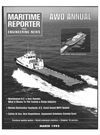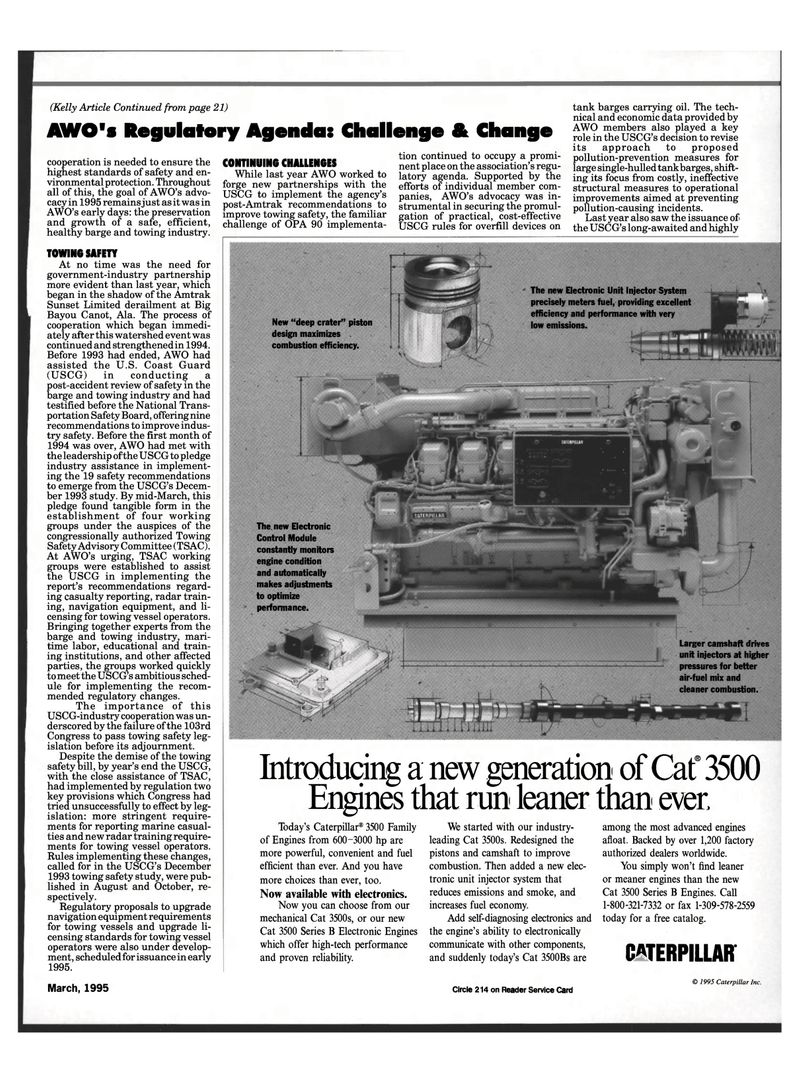
Page 25: of Maritime Reporter Magazine (March 1995)
Read this page in Pdf, Flash or Html5 edition of March 1995 Maritime Reporter Magazine
(Kelly Article Continued from page 21)
NNOMs Regulatory Agendas Challenge & Change cooperation is needed to ensure the highest standards of safety and en- vironmental protection. Throughout all of this, the goal of AWO's advo- cacy in 1995 remains just as it was in
AWO's early days: the preservation and growth of a safe, efficient, healthy barge and towing industry.
TOWING SAFETY
At no time was the need for government-industry partnership more evident than last year, which began in the shadow of the Amtrak
Sunset Limited derailment at Big
Bayou Canot, Ala. The process of cooperation which began immedi- ately after this watershed event was continued and strengthened in 1994.
Before 1993 had ended, AWO had assisted the U.S. Coast Guard (USCG) in conducting a post-accident review of safety in the barge and towing industry and had testified before the National Trans- portation Safety Board, offering nine recommendations to improve indus- try safety. Before the first month of 1994 was over, AWO had met with the leadership of the USCG to pledge industry assistance in implement- ing the 19 safety recommendations to emerge from the USCG's Decem- ber 1993 study. By mid-March, this pledge found tangible form in the establishment of four working groups under the auspices of the congressionally authorized Towing
Safety Advisory Committee (TSAC).
At AWO's urging, TSAC working groups were established to assist the USCG in implementing the report's recommendations regard- ing casualty reporting, radar train- ing, navigation equipment, and li- censing for towing vessel operators.
Bringing together experts from the barge and towing industry, mari- time labor, educational and train- ing institutions, and other affected parties, the groups worked quickly to meet the USCG's ambitious sched- ule for implementing the recom- mended regulatory changes.
The importance of this
USCG-industry cooperation was un- derscored by the failure of the 103rd
Congress to pass towing safety leg- islation before its adjournment.
Despite the demise of the towing safety bill, by year's end the USCG, with the close assistance of TSAC, had implemented by regulation two key provisions which Congress had tried unsuccessfully to effect by leg- islation: more stringent require- ments for reporting marine casual- ties and new radar training require- ments for towing vessel operators.
Rules implementing these changes, called for in the USCG's December 1993 towing safety study, were pub- lished in August and October, re- spectively.
Regulatory proposals to upgrade navigation equipment requirements for towing vessels and upgrade li- censing standards for towing vessel operators were also under develop- ment, scheduled for issuance in early 1995.
CONTINUING CHALLENGES
While last year AWO worked to forge new partnerships with the
USCG to implement the agency's post-Amtrak recommendations to improve towing safety, the familiar challenge of OPA 90 implementa- tion continued to occupy a promi- nent place on the association's regu- latory agenda. Supported by the efforts of individual member com- panies, AWO's advocacy was in- strumental in securing the promul- gation of practical, cost-effective
USCG rules for overfill devices on tank barges carrying oil. The tech- nical and economic data provided by
AWO members also played a key role in the USCG's decision to revise its approach to proposed pollution-prevention measures for large single-hulled tankbarges, shift- ing its focus from costly, ineffective structural measures to operational improvements aimed at preventing pollution-causing incidents.
Last year also saw the issuance of the USCG's long-awaited and highly
Introducing a new generation of Cat* 3500 Engines that run leaner than ever.
Today's Caterpillar® 3500 Family of Engines from 600-3000 hp are more powerful, convenient and fuel efficient than ever. And you have more choices than ever, too.
Now available with electronics.
Now you can choose from our mechanical Cat 3500s, or our new
Cat 3500 Series B Electronic Engines which offer high-tech performance and proven reliability.
We started with our industry- leading Cat 3500s. Redesigned the pistons and camshaft to improve combustion. Then added a new elec- tronic unit injector system that reduces emissions and smoke, and increases fuel economy.
Add self-diagnosing electronics and the engine's ability to electronically communicate with other components, and suddenly today's Cat 3500Bs are among the most advanced engines afloat. Backed by over 1,200 factory authorized dealers worldwide.
You simply won't find leaner or meaner engines than the new
Cat 3500 Series B Engines. Call 1-800-321-7332 or fax 1-309-578-2559 today for a free catalog.
CATERPILLAR
The new Electronic Unit Injector System precisely meters fuel, providing excellent efficiency and performance with very low emissions. New "deep crater" piston design maximizes . combustion efficiency.
The, new Electronic
Control Module constantly monitors engine condition and automatically makes adjustments to optimize performance.
Larger camshaft drives unit injectors at higher pressures for better air-fuel mix and cleaner combustion.
March, 1995 Circle 214 on Reader Service Card © 1995 Caterpillar Inc.

 24
24

 26
26
